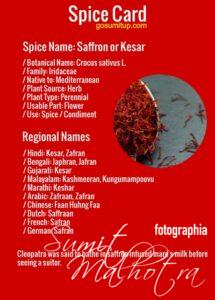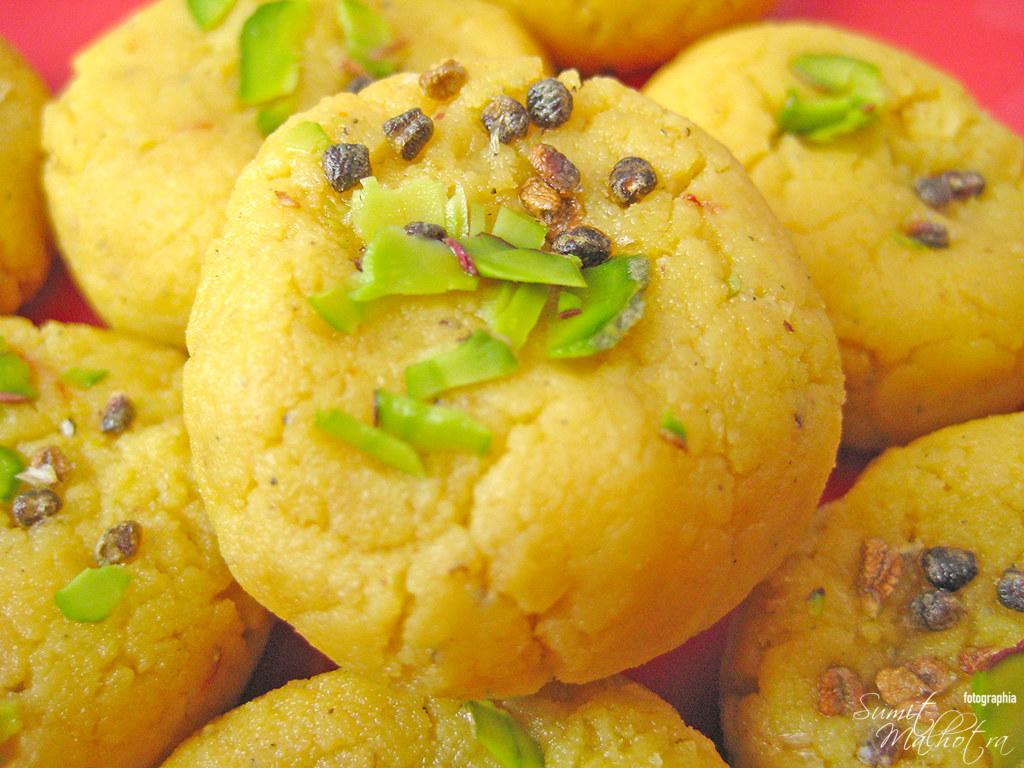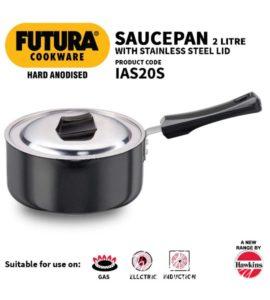All About Saffron | Know Your Spice Kesar (Crocus sativus L.)
Saffron is a spice derived from the flower of Crocus sativus L., commonly known as the “saffron crocus“. It belongs to the Iridaceae
The vivid crimson stigma and styles, called threads, are collected and dried for use mainly as a seasoning and colouring agent in food.
Kesar has been the world’s most costly spice by weight for long.
It was first grown in Iran, where currently about 90% of the global production comes from.
Other producing countries are Spain, Greece, Italy, Morocco, Egypt, Israel, New Zealand, Australia, Pakistan, and India. In India, it is cultivated in Jammu & Kashmir and in Himachal Pradesh.
What are the other names of Saffron?
| Indian Languages | Other Languages | |
| Hindi: Kesar, Zafran Bengali: Japhran, Jafran Gujarati: Kesar Malayalam: Kashmeeran, Kungumampoovu Marathi: Keshar Punjabi: Keshar, Kesar Sanskrit: Kumkuma, Kashmiirajan, Kashmiiran Tamil: Kungumapu Telugu: Kunkumapuvvu | Latin (Botanical): Crocus sativus L. Arabic: Zafraan, Zafran Chinese: Faan Huhng Faa Dutch: Saffraan French: Safran German: Safran Italian: Zaffarano, Zafferano Spanish: Azafrán Swedish: Saffran |
What exactly is Saffron?
Kesar plant, Crocus sativus L., is a bulbous, perennial with globular corms, 15-20 cm high.
It has 6 to 10 leaves present at anthesis, one to two flowers with a lilac-purple colour with perianth segments of 3.5 – 5 cm and style branches of 2.5 – 3.2 cm.
The yellow style is deeply divided into three branches and the stigmata are bright red.
Flowers are arising directly from the corms. Flowers have tri-lobed stigma, which along with the style tops yield the saffron of commerce.
Zafraan is an ancient spice whose beneficial properties have been known for a long time.
What is the nutritional value of Saffron?
Kesar contains 310 calories per 100 g serving. One serving contains 5.9 g of fat, 11 g of protein and 65 g of carbohydrate.
The latter is g sugar and 3.9 g of dietary fiber, the rest is complex carbohydrate.
Kesar or Saffron is an excellent source of minerals like copper, potassium, calcium, manganese, iron, selenium, zinc and magnesium.
It is also rich in many vital vitamins, including vitamin-A, folic acid, riboflavin, niacin, and vitamin-C.
What is the chemical composition of Saffron?
150 chemical compounds have been extracted from kesar, but only about one third of them have been identified.
The chemistry of zafraan is complex; this spice has primary metabolites, which are ubiquitous in nature, such as carbohydrates, minerals, fats, vitamins, amino acids, and proteins.
A large number of compounds belong to different classes of secondary metabolites. Carotenoids are the most important constituents of the spice, from which it derives its color.
They include α- and β-carotene, lycopene, and zeaxanthin, and apocarotenoid crocetin (C20H24O4) and crocins, the polyene esters of the mono- and di-glycoside crocetin.
What is the history of Saffron?
Saffron-based pigments have been found in the prehistoric paints used to depict beasts in 50,000-year-old cave art in what is today Iraq.
Later, the Sumerians used it as an ingredient in their remedies and magical potions. However, Sumerians did not actively cultivate it.
They instead chose to gather their stores from wild flowers only, because they felt that only divine intervention would enable it’s medicinal properties.
The first images of Crocus sativus (kesar) flowers we know of have been found on earthenware pots in Minoan palaces.
The oldest, well-known image can be seen on a pot that was made around 2000 – 1800 BC, so 3800 to 4000 years ago.
Cleopatra was said to bathe in saffron-infused mare’s milk before seeing a suitor.
In Santorini, several women are harvesting zafran on mural paintings. Another woman uses Saffron to color her lips, possibly in preparation for a religious ritual.
Excavations in the entire area around the Mediterranean show that Saffron – along with tin – was the main trade product of the Minoan civilization.
The wealth of the inhabitants of Crete and surrounding islands was therefore based for a considerable part on kesar.
It was so important at that time that people everywhere depicted Saffron: on murals, on pots, bowls and vases, and on clothes.
Poets have romanticized it, monks have worn clothes dyed with its color, emperors have dreamt of it and saints have worshiped it. Stories around the golden spice abound.
According to one, Mughal Emperor Akbar loved the smell of Zafraan so much, that the large windows in the bathhouses of his palaces, especially in Rajasthan, would overlook Zafraan fields.
It is said he loved the scent of the golden spice to waft through the windows and perfume the air.
What are the uses of Saffron?
- It is used for cosmetic purposes, absorbed in infusion or even in the cutaneous application.
- As per traditional Iranian medicine, Zafraan can improve the complexion and can be used to treat erysipelas.
- As per traditional Greek medicine, it can refresh the skin of the face and is used to relieve the liver of the domination of bile and to treat acne, skin diseases and wounds.
- Kesar is known to have anti-sun effects that can protect the skin from harmful UV rays.
- A mixture of soaked Zafraan strands and virgin coconut oil, or olive oil, and a bit of raw milk is an effective way to exfoliate and improve blood circulation face skin.
- It is used in the composition of different perfumes both feminine and masculine, with an original and exotic potential.
- The use of kesar as an antidepressant has a long tradition, ranging from antiquity to modern times.
- Traditionally, Muslims, Phoenicians and Chinese use Zafraan as a sexual stimulant.
- From antiquity to the present day, and all over the world, most of the Zafraan produced was, and is still used, in cooking.
What does Saffron taste like?
Taste of Saffron is sweet with floral notes. Its aroma resembles that of honey, but with metallic notes.
What are the ayurvedic properties of Saffron?
Rasa (Taste): Katu (Pungent), Tikta (Bitter)
Guna (Qualities): Snigdha (Oily)
Veerya (Potency): Usna (Hot)
Vipaka (Taste conversion after digestion): Katu (Pungent)
Karma (Actions): Tridoshahara (Reduces all the vitiated doshas)
What can I use Saffron for?
- Use Zafraan as a culinary seasoning.
- Use it to to colour & flavour cottage cheese, chicken and meat, rise, mayonnaise, liquors and cordials.
- Use it in speciality breads, cakes, confectionaries, Mughlai dishes.
- From the Kashmiri kahwa to saffron rice, to sweets, Rogan Josh, Yakhani (light curry/broth); the use of kesar is integral to Kashmiri cuisine.
- Most traditional recipes calling for Zafraan are grain-based, including risotto, pilaf, and paella or even just rice.
- Use it for your desserts like kheer, peda, custard, plain pastry, and sweet breads.
- Drinking kesar milk is commonly believed to help brighten your complexion.
- Use it for your saffron tea (the recipe is given below).
How do I prepare Saffron for food?
- The Soaking method: Take the threads you intend to use for the recipe and crush them using your fingers. Steep the crushed threads in warm water or milk, stock or white wine for 20 to 30 minutes. Use as the recipe indicates.
- The Toasting method: Place a cast iron skillet on the stove over medium heat. Add the threads to the hot skillet. Stirring frequently to cook, for a minute not letting it burn. Cool and grind the toasted threads using a mortar and pestle. Use as the recipe indicates.
How long does Saffron last?
Store saffron in an airtight container in a cool, dark place for up to six months for maximum flavour.
How do I store Saffron?
Wrap the saffron threads in foil and place them in an airtight container. Store them in a cool, dark place for up to 6 months. For longer storage, keep the container of saffron in your freezer for up to 2 years.
Is there a substitute for Saffron?
- Turmeric is referred to as the “saffron of the Indies”. If you’re cooking a dish that needs color, then turmeric is a good option. Turmeric adds its flavour too.
- Safflower also known as “Mexican saffron” won’t give you the delightful flavour or aroma offered by saffron; but, it will provide a similar vibrant color for your food.
- Annatto is known as “poor man’s saffron” and makes an excellent saffron replacement.
Where do I buy Saffron from?
Saffron is readily available in most large grocery stores and specialty markets. Due to its value, it may be stocked in a locked or secured area.
If you don’t see any on the shelf, ask the store attendants. You can also order it online via amazon.
What are the health benefits of Saffron?
The following are health benefits of Saffron (Crocus sativus L.) or Kesar
- Health Benefits of Saffron as an Antioxidant – Saffron is rich in both antioxidants and flavonoids. Antioxidants help protect the body from harmful substances. Flavonoids are chemicals found in plants that help the plant protect itself from fungus and disease.
- Health Benefits of Kesar for Heart – It was found that saffron reduced the possibility that bad cholesterol would cause tissue damage. Researchers believe that the antioxidant properties of saffron might have a protective effect when it comes to heart disease.
- Health Benefits of Kesar as a Memory Booster – Saffron contains two chemicals, crocin and crocetin, which researchers believe may help learning and memory function.
- Health Benefits of Saffron against Cancer – A 2015 review in the Journal of Traditional and Complementary Medicine found that the chemical makeup of saffron may be effective in preventing and treating several different cancers.
- Health Benefits of Kesar against Nervous System Ailments – Research from 2015 claims that compounds in saffron, such as crocin, appear to reduce inflammation and oxidative damage in the brain, which may lead to beneficial effects.
- Health Benefits of Saffron for Mood – Research suggests that taking 30 milligrams (mg) of saffron each day could cause similar effects as drugs that treat mild-to-moderate depression, such as imipramine and fluoxetine.
- Health Benefits of Kesar for Sexuality: Saffron may also increase sex drive and sexual function in both males and females.
- Health Benefits of Saffron for Premenstrual Syndrome: Saffron may also act to reduce the symptoms of premenstrual syndrome (PMS).
- Health Benefits of Kesar for Weight Loss: There is also some evidence to suggest that saffron may help promote weight loss and curb the appetite.
- Health Benefits of Saffron for Skin Care: In addition to the antisolar and moisturizing properties of saffron, the prevention of skin cancers by saffron because of its antioxidant properties is important as well
- Health Benefits of Kesar for Digestion: Virtues have been attributed to saffron concerning the gastrointestinal system, in particular, those of stimulating the stomach, reducing appetite, treating hemorrhoids etc.
- Health Benefits of Saffron’s Anti-Inflammatory and Analgesic Effect: Extracts and tinctures of saffron have been used to treat fever, wounds, lower back pain, abscesses, and gingivitis as well as pain related to the eruption of the first teeth in infants.
- Health Benefits of Kesar against Diabetes: The use of high-dose crocetin (40 mg/kg) counteracts the development of insulin resistance by avoiding compensatory hyperinsulinemia.
Saffron - Saffron Tea Recipe | How to make Saffron Tea
Ingredients
- 1.5 Cup Water
- 15 gram Saffron Roughly 10-12 Strands
- 1 inch Cinnamon
- 1 teaspoon Fresh Ginger Grated
- 0.5 Piece Lemon
- 10-12 Piece Fresh Mint Leaves
Instructions
- Bring a cup of water to boil
- Add saffron strands.
- Add other spices for flavour (cinnamon, ginger, lemon, and mint)
- Let it all steep for 5-6 minutes
- Strain & pour yourself a hearty kesar chai.
Notes
- Saffron Tea or Kesar Chai is subtly earthy and grassy notes with sweet, floral, honey-like undertones.
- If you like you tea sweeter, simply add some honey to taste.
- You may choose to add cardamom to saffron tea as well if you like the taste.
Tools & Equipment Used For This Recipe
FInally! To Sum It Up
Kesar plant, Crocus sativus L., is a bulbous, perennial with globular corms, 15-20 cm high.
It has 6 to 10 leaves present at anthesis, one to two flowers with a lilac-purple colour with perianth segments of 3.5 – 5 cm and style branches of 2.5 – 3.2 cm.
The yellow style is deeply divided into three branches and the stigmata are bright red.
Flowers are arising directly from the corms. Flowers have tri-lobed stigma, which along with the style tops yield the saffron of commerce.
Saffron is an ancient spice whose beneficial properties have been known for a long time.
STAY CONNECTED
If you like this article, you can let us know in the comments below or on social media using #gosumitup and tag @gosumitup.
I am always happy to read your feedback and if you liked the dish or if you made the dish. :)
Better still, take a picture and post it on Instagram and tag it as #gosumitup
Connect direct – You can also connect with me directly on my Instagram and Facebook or on Pinterest.
And, keep visiting us for more of such awesomeness. Do bookmark gosumitup.com into your web browser now or simply subscribe to our browser notifications.
This article has been compiled for general information only and should not be used for the diagnosis or treatment of any medical condition/s.
This information is not intended to diagnose, treat, cure, or prevent any disease.
GoSumItUp.com has used all reasonable care in compiling the information but offers no warranty as to its accuracy or its use in any possible form.
Consult a doctor or other health care professional for diagnosis and treatment of any medical condition/s. For more details please refer to our disclosure policy.





